A
| Aikey Brae stone circle or Parkhouse stone circle |
|---|

Elliptical Recumbent Stone Circle; Widest diameter 16.6 metres, narrowest diameter 12.8 metres five erect stones including recumbent and E pillar, five prostrate stones including W pillar. They are set upon a bank of small stones and earth 1.92m x 0.76m. c14.4 m in diameter, with kerbs formed by slab-like stones on the inner and outer faces, it appears flat, however below the surface, the interior is made up, at least partially, of a mass of small boulders. It was a considerable feat to haul all the great stones of the ring, including the massive, whale-like recumbent (weighing 21 tons), into position on this bank. Such banks are a particular feature of recumbent Stone circles in Buchan. |
B
| Bagpuss faux windows, Peterhead |
|---|

False shop window murals on plywood one is a homage to the 1970s children's TV programme 'Bagpuss' created by Oliver Postgate and Peter Firmin. The other represents an antique shop at the turn of the last century. Commissioned by the Aberdeenshire Towns Partnership to aid the regeneration of the area. More Information |
F
| Fisher Jessie sculpture |
|---|
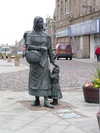
Naturalistic bronze cast statue of a fish-wife and little girl, the woman carrying a creel and a basket. More Information |
| Fishermens Memorial, Peterhead |

Size overall: 180cm x 350cm x 50cm, sail shaped cast bronze relief modelled with scenes of early 20th century fisher life, mounted on a granite slab. |
G
| Gold Close 7 Kirk St Peterhead |
|---|

The rough walls of a narrow close (a covered alley) 20' feet long 4' wide and 10' high, in a street of pink and grey granite tenements. The artist has covered the walls with gold lead thus creating a light installation when the sun illuminates it. The reflected light emphasises architectural features that were previously obscured by the general deriliction and old surface coatings. The work creates an intense visual impact on the street in the right light conditions. More Information |
M
| Maud War Memorial |
|---|
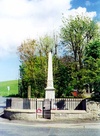
A war memorial in the shape of a four sided obelisk on a pedestal with a relief motif of crossed rifles and laurel wreath. It commemorates the dead of both World War I & II. It has a rectangular base sitting on a two-step plinth. More Information |
| Meethill monument - Reform tower Peterhead |
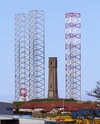
A tall tapering five storey tower, Greek cross in section, with a crenellated parapet corbelled out over the remainder. |
N
| North Sea first air crossing memorial |
|---|
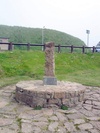
A small monolith of pink Peterhead granite set upright on a rotunda of masonry itself set on a pavement of irregular slabs all in rough Peterhead granite, a bronze plaque has this inscription "From the sands of Cruden Bay on the 30th July 1914 the Norwegian Aviator Kommander Tryggve Gran D.F.C made the first crossing of the North Sea by air." |
P
| Peterhead Pends |
|---|
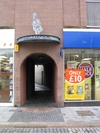
As part of an attempt to regenerate the area and preserve the historic associations of the pends and closes running back from the street they were given these canopies with cut metal signs, |
| Peterhead video piece |

The artist (Dutch film maker, Jean Bei Ning) filmed local residents walking in front of a mobile blue screen. This footage was then mounted into slides showing landmarks in Tibet, Africa, Scotland, Thailand, Syria and Indonesia. This created the effect that local people were travelling in 'other worlds'. The artist also produced a sound piece located elsewhere in the town consisting of stories recorded in interviews with local people. More Information |
| Peterhead War Memorial |
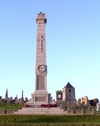
It is a tall rectangular obilisk with an unusual decorated top. The name plaques are near the base of the sides within egg & dart borders, each surmounted by a wreath. Above the wreath on one face is a cross. The obilisk stands on a slightly splayed base on top of a three-step base. It was unveiled 6 August 1922 and handed over to the Town Council on August 6 1923. The World War II memorial forms the gate piers in to the churchyard. They are squat rectangular pillars with the coats-of-arms of the different services and regiments as well as the names. Inside the churchyard is another memorial to the men buried in the churchyard and three other war graves. More Information |
| Peterhead, Late Victorian Datestone |

One of several ornate carved 19th century datestones on buildings in the town centre. The pink Peterhead granite is the towns signature material. The metal spikes are an attempt to limit nesting places for the Herring Gulls that throng this fishing port in huge numbers. More Information |
R
| Reform Monument |
|---|

Monument; erected in 1833 , it was erected by local ‘Tories’ (Conservatives) on the site of the market cross to celebrate Parliamentary reform. A Roman Doric column surmounted by the arms of the Earl Marischal with a lion above; this coat of arms was originally in a gateway to Inverugie castle, recently restored. |
S
| Statue of Marshall Keith |
|---|
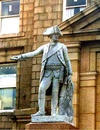
1869. August 16th Marshal Keith monument unveiled by the Earl of Kintore. |
| Stephen Healy & Sperm Whale |

Glasgow based Stephen came to an outsider’s conclusion, based on the architectural layout and history of Peterhead that he had observed, that “Peterhead is and has always probably been an unpretentious working class community. Taking into account the town's social and economical history and its reliance and existence on the fishing industry, there seems to be a functional no nonsense attitude when it comes to the towns general look." He also noted a lack of any decadence with the town’s character, in the form of frills, “aesthetics for aesthetic sake”. His intervention aimed to address some of these issues that the granite town portrays. |
| Sustrans Way Marker |

A "Sustrans" bicycle route way marker on the route of the Buchan Way that follows the disused railway route. More Information |
This content was submitted by external contributors and does not necessarily reflect the views of the University of Aberdeen.
